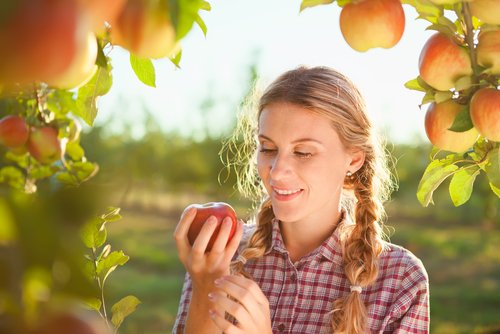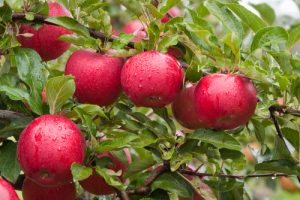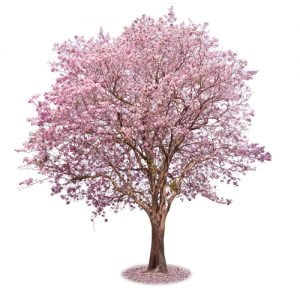
General Considerations
Planting a tree in your garden can bring good all-round paybacks. As we all know, a tree is good for the environment and can also attract wildlife, as well as add colour and interest, to any garden. However, if you decide to plant a fruit tree it obviously has the added bonus of being able to produce a pleasing crop of fruit for consumption. Furthermore, it’s possible to successfully grow a fruit tree in even the smallest garden as long as a few simple guidelines are followed.

Apples are the most popular fruit grown in the UK
Any tree will help to screen-out an unattractive view, and if you live near a busy road, it can help to filter out noise and air pollution. It will also benefit nature by providing pollen for insects, a shelter for birds, and converting carbon dioxide in the atmosphere into oxygen. And, if a tree growing too tall is a concern, it’s possible to keep many fruit trees compact by regular pruning. Typically, many varieties of fruit tree can be easily be restrained to growing no more than 4 m in height. If you have a particularly small garden, then you could plant a dwarf or semi-dwarf fruit tree.
In the UK and most other temperate climates, by far the most common types of fruit trees are apple, pear, plum and cherry. The most important thing to know when planting a fruit tree, especially true of the four common mentioned, is that most varieties are self-sterile. In effect, this means that they are incapable of setting their own fruit with their own pollen. Thus, it’s important to ensure that that the flowers of these types are fertilized with pollen from flowers of another variety of the same fruit. Cherries prove to be especially tricky, as most varieties require at least two different pollens to successfully achieve cross-fertilization.

Cherry trees are particularly difficult to cross-pollinate
Which Varieties?
There are still relatively few varieties of apple, cherry, pear and plum which are a proven success at self-fertility. However, the numbers becoming available on the market for each fruit are steadily growing. Red Devil and Scrumptious are two of a few varieties of apples whose flowers are self-pollinating. One of the very few varieties of pear that are self-fertile is Louise Bonne of Jersey, with Victoria being one of the few types of self-pollinating plum. Most sweet, eating varieties of cherry are self-sterile, and while a few sour varieties used in cooking, like Morello and Kentish Red are self-fertile. However, even these tend not to do too well when grown in isolation. In fact, all fruit trees, whether described as being ”partially self-fertile” or fully ”self-fertile”, will generally benefit from cross-pollination. At least, in terms of the quality and quantity of the crop they will produce.
If don’t have room for more than one fruit tree in your own garden, it would obviously be best to choose a self-fertile variety of fruit to grow. However, pollen is carried by bees and the wind, so cross-pollination of the flowers of two varieties of the same fruit in the same locality is highly likely. Thus, if you are lucky enough have a neighbour already growing your favoured fruit, then the greater the choice you will have in picking your variety of choice. Alternatively, you could always rope a friendly neighbour to your project, getting them to grow a different variety of the same fruit tree. However, it should be noted that the different varieties of fruit blossom, do have their favoured (one or more) pollinating partner(s). It’s these favoured partners that will help the tree flourish and produce the greatest fruit crop yields. There are dedicate websites online where you can check which are the best pollinating partners for the particular variety of fruit tree you want to grow.
When to plant
Fruit trees can be planted at any time that the plant is dormant. In the UK, that’s generally between the end of October and the end of March. However, neither should the tree be planted when conditions are too frosty nor too wet. Ideally, the plant hole should be dug on the same day as planting.
Planting procedure
- Decide on the right spot in the garden, making sure its both airy and not prone to shadow.
- Place your new tree, while still in its pot, in a bucket of water for a good soaking.
- Dig a hole to a depth that matches the depth of the tree’s root ball, checking that the soil mark on the stem coincides with the surrounding ground level.
- Remove the tree from its pot and place it centrally in the hole. Place a support stake next to the tree before the roots are covered in with soil.
- In general, the stake should extend to at least the bottom branch, or higher. For tying, use a tarred twine or another strong tying material.
- If the backfill soil is particularly poor then mix in a few scoops of manure, otherwise, no soil enrichment is necessary.
- Re-fill the hole with soil, trampling it in underfoot, which will achieve the appropriate firmness.
- Water well around the newly planted tree. Add mulch to prevent weeds growing and enhance moisture retention.
Watering and feeding
The first spring and summer after planting are when fruit trees especially need plenty of water. The soil around the tree shouldn’t be allowed to dry out or crack and the tree should be given at least a bucketful of water on regular occasions. Before watering, form holes in the ground above the tree roots with a garden fork. Alternatively, make an earth ridge about 3” (75 mm) high, at a radius of 18” (450 mm) around the tree trunk, effectively forming a basin. Fill the basin with water, eventually allowing it to soak through to the tree roots.
Fruit trees should not be fed with any form of nutrients until they have successfully developed the fruiting habit. After that, they can be fed at any time in line with recommendations for the particular type and variety of the tree.
If you’ve enjoyed reading this article, why not click on the link to Hobbies and Pastimes, to see if there’s anything else that takes your interest?





